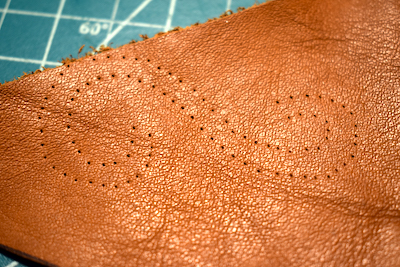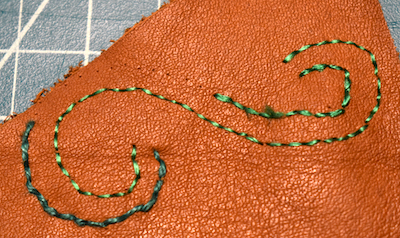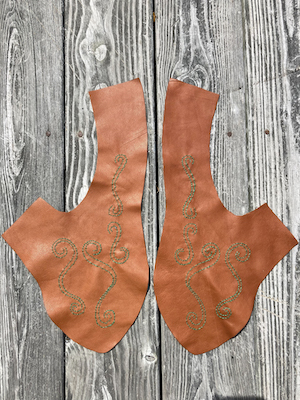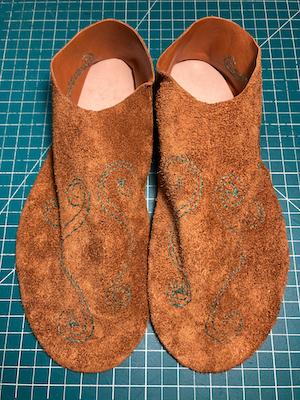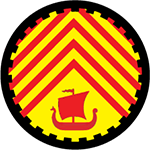
Shoes by Robert
Eastern Embroidery
Having been studying embroidery on leather for some time now, but not having tried the Eastern European style yet, it was fortuitous to receive a shoe-making request with great potential for trying it. (With Eastern European leather embroidery the needle and thread go into and out of the leather, unlike that from Norway and other places where it stays within the thickness of the leather.)
With Russian-translation assistance from Lady Aurélie and in consultation with Cristina inghean Ghriogair, who will wear them at her Laurel elevation, we decided upon a basic soft-shoe type known as choboti. We found documented shoe designs that match the elevation garb to be worn on the occasion.
The leather used for this project came from a scrap pile at Pennsic. It's soft and supple, and I noticed it while looking for material for a different project. It seemed like just the thing for these shoes, although I don't know how it was tanned. It's thick enough for butt-edged side seams, but thin enough to not require a great deal of effort to punch awl holes for the thread, and also stetchy enough to close around those holes after applying the embroidery.
The design implemented is not particular to any of the illustrated examples, but one that combines elements of different shoes. Using a piece of canvas, I sketched out a design in pencil, and then overlaid it onto both uppers (one upside down). Then I used an awl to punch a series of holes not only to transfer the pattern, but also to serve as passage holes for the embroidery needle. No publication I've found yet states whether the drawings of archaeological finds show the actual embroidery holes are or merely representational. Therefore I poked holes at different distances: further from each other on straight sements, closer together on curves proportional to the degree of curvature.
It was not clear what kind of thread was used on many of the originals, but in general reading leads on to believe it was most likely to have been silk, although sometimes linen survives. Before commiting either way, I made test samples with single and double threads of unspun silk, and one of spun linen. Although I prefer the shine of the silk, the linen stands higher on the surface for a better overall effect. The stitch was very simple, just up and down through the holes skipping one section each time, then at the end reversing course to cover the gaps.
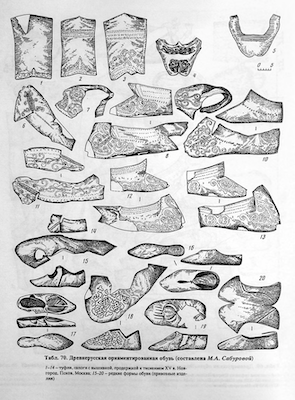
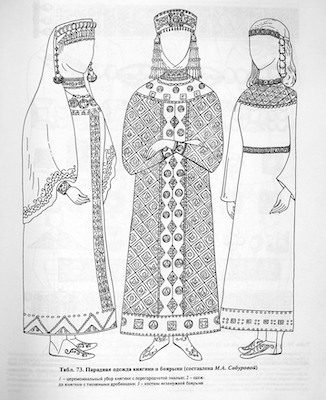
The two images above come from РОССИЙСКАЯ АКАДЕМИЯ НАУК ИНСТИТУТ АРХЕОЛОГИИ ("Early Rus Life and Culture"), 1997, by Kolchin, B. A. and Makarova, T. I.
From the text translated by Lady Aurélie, we find that "choboti are considered the earliest form of hard soled shoes, their main charesterictics being: very soft top part, somewhat harder soles and low topbands. These shoes could be cut low in front and have no ties, or have a higher vamp and tie at the ankle." Also, "this type of shoe was divided into two main categories: single piece top pattern, with an added sole, and a multiple piece pattern top, and an added sole. The single pattern shoe was made in two different variations: with a seam along the side or with a seam along the back. Those shoes were tied either around the ankle or on the rise of the foot."
For the embroidered decoration: "Later, 10c to 13c, the ornamentation became more variant. There have been found shoe embroidery of stylized plant shoots and roots, diamond, arrow and circular designs. The same decorative designs can be found in clothing and headwear and even architectural ornaments." and "the embroidery was done using wool, silk and linen thread, dyed in bright colors such as red, green, yellow and other colors."
Last updated Sept. 5, 2022.
